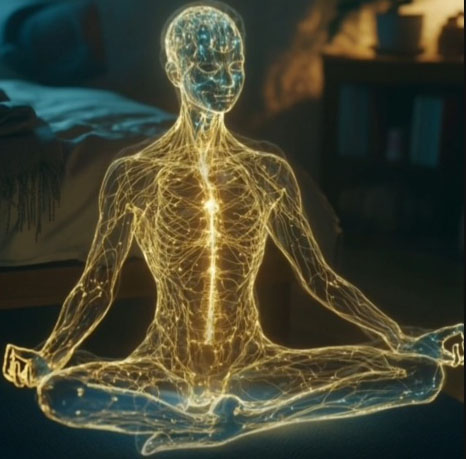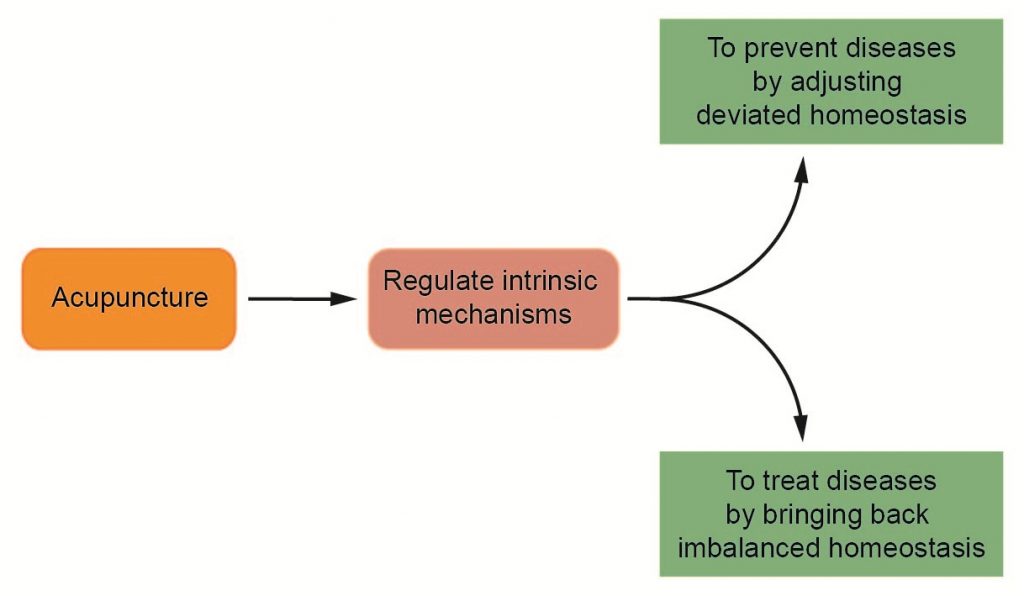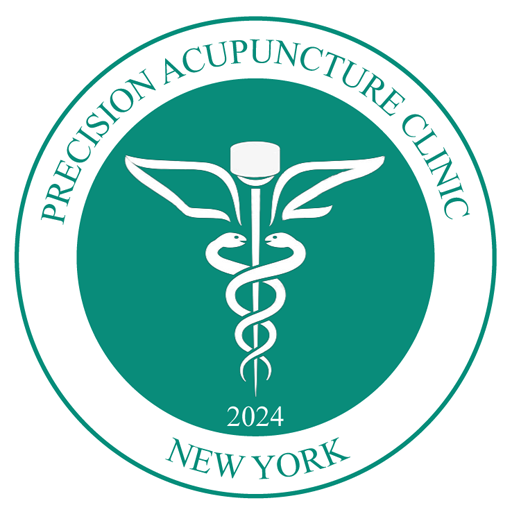As a clinical practice for over 2,200 years, acupuncture was initially developed in China, later spread worldwide, and now is still under development with the incorporation of modern medical findings and technological advancement. As a result, the practice of acupuncture exists in various formats and is guided by various theories or principles. Thus, the following is not a summary or review of the current status of acupuncture. Rather, the following serves as a way to communicate with patients and readers and share Dr. Zhou's current, personal understanding of acupuncture in a very brief format, which, of course, is limited.
Principles of acupuncture
Acupuncture considers the human body as a whole in which the materials, such as molecules, cells, tissues, and fluids, and the physiological functions and energy of those materials are connected in specific ways, and thus, the clinical symptoms not only manifest in local areas but also in distant regions according to the acupuncture meridians. In fact, acupuncture meridians and the acupoints along those pathways are the key findings from thousands of years of acupuncture practice in China, during which ancient Chinese medical doctors evidenced the clinical therapeutic effects of needling through those meridians at specific acupoints. The idea of acupuncture meridians is illustrated on the right using an imaginary image for the purpose of explanation. In reality, those meridians are a means of the pathways that ancient Chinese medical doctors identified for treating diseases at specific locations, called acupoints, where acupuncture needling techniques can result in both local and whole-body clinical effects.

An imaginary image to illustrate the idea that a human body is connected via acupuncture meridians and the acupoints along those pathways.
Acupuncture emphasizes the flow of the above-mentioned molecules, cells, tissues, and fluids and how such physiological flow regulates and maintains the homeostasis of human body health, the imbalance of which then leads to diseases. To this end, ancient Chinese doctors developed Traditional Chinese Medicine (TCM) to guide the practice of acupuncture toward bringing clinical benefits to people. For example, some meridians and their acupoints are close to the following key tissues: veins, arteries, lymphatics, and nerves. As such, needling at those acupoints may influence the physiological functions of those tissues to regulate (promote or inhibit) the nervous, cardiovascular, and immune systems in a specific way. More interestingly, those effects can happen in both local and distal regions of the human body. From this, we can appreciate the key clinical benefits of acupuncture is two-fold:
1) Regulate the physiological functions by affecting the above systems locally and distantly to maintain, strengthen, and optimize the homeostasis of the human body of people with subclinical conditions, which may help in the prevention of diseases;
2) Adjust the imbalanced disease status by stimulating the above systems locally and distantly in specific ways to adjust weakened or overacting tissues, organs, or organ systems, bringing back the normal homeostasis of a human body or expelling pathogenic factors to achieve clinical therapeutic effects, which may help patients with clinical symptoms.

Two-fold healthy benefits of acupuncture
Because of the above mechanisms, acupuncture can be an effective therapeutic method for a variety of diseases, especially those that can benefit from the re-balancing of the body systems from acupuncture treatment. In this perspective, we can consider such treatment as "treating from within to regulate" compared to "treating from outside to intervene" of regular Western medical treatments that utilize medications that target a specific pathological process(es) or surgeries that remove abnormal structures and add beneficial structures. Hence, acupuncture can be an excellent treatment approach that is complementary to mainstream Western medicine.
Practice of acupuncture
Based on the above discussion, an important, classical, effective way to practice acupuncture is as follows:
- To make a TCM diagnosis to identify the imbalance of the human body’s homeostasis, which guides the acupuncture treatment
- To determine the current focus of the treatment in consideration of the imbalance and a patient’s personal body constitution (one kind of personalized medicine or precision medicine)
- To design a systemic treatment plan
- To implement the treatment plan by various modalities, such as regular acupuncture, electroacupuncture, and moxibustion, for the proposed sessions
- To adjust treatment principles and focus based on the change in a patient’s healthy status in TCM terms
The above approach is adopted at our Precision Acupuncture Clinic. According to this authentic TCM approach, our patients can refer to the following flow chart that depicts a regular treatment process at our acupuncture clinic.

A regular process of acupuncture treatment of the chief complaint
Safety of acupuncture
Due to the use of fine, stainless steel needles called filiform needles, acupuncture treatment is relatively safe. Those needles are to be inserted at specific acupoints in the connective tissues under the skin or inside the muscles, avoiding blood vessels, nerves, or other important body structures. In addition, modern needles used in the U.S. should be disposable needles used just once on a single patient. Furthermore, the design of our Precision Acupuncture Clinic is focused on preventing healthcare-related cross-contaminations by implementing multi-level controls of engineering, administrative, and personal protective equipment. In sum, our philosophy is to ensure safety before we bring the treatment effects and that ensuring the safety of patients is the foundation for bringing beneficial therapeutic outcomes of acupuncture treatment.
Finally, the following are common contraindications of acupuncture treatment:
1) certain acupoints during pregnancy (LI4, SP6, UB60, UB67, BL31~34, GB21);
2) patients with uncontrolled movements;
3) patients on anticoagulant therapy or with blood clotting
disorders;
4) when patients have low blood glucose (hypoglycemia);
5) when patients have too low or too high blood pressure;
6) when patients are hungry, just after a meal, or too tired, among other
conditions.
Schedule Appointments
Only one patient can be scheduled for one treatment hour, which ensures that each patient receives full attention during the clinic visit. However, a patient can come early to wait in the waiting area.
Please book an appointment online by clicking the Book an Appointment icon. The direction to our clinic can be found by clicking the Google Maps icon. Please feel free to contact us by email or phone.
Dr. Zhou’s availability:
If you have any issues with booking an appointment at your convenient time, please do not hesitate to contact us at (929)688-2567 or info@precisionacupunctureclinic.com. We will do our best to accommodate you.
We are located at
90 North Broadway
Suite 211
Irvington, NY 10533
